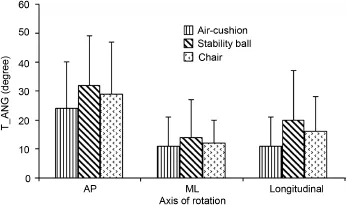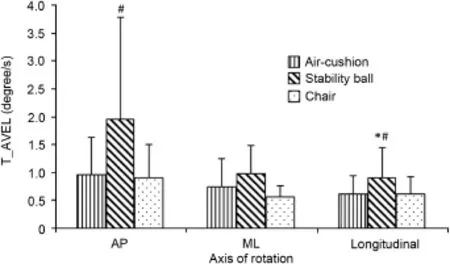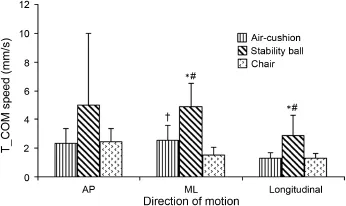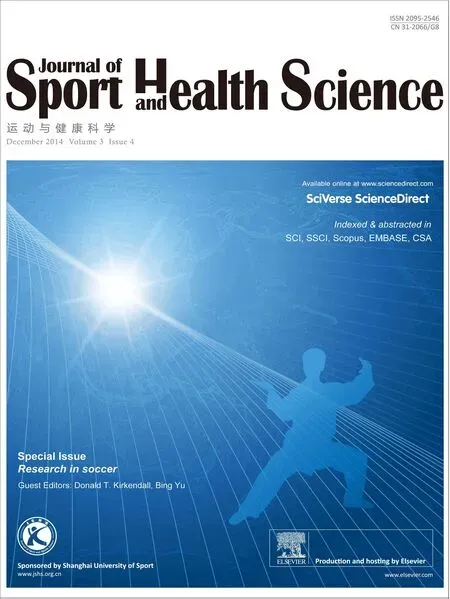The effect of active sitting on trunk motion
Henry Wang,Kaitlyn J.Weiss,Mason C.Haggerty,Jacqueline E.Heath
School of Physical Education,Sport,and Exercise Science,Ball State University,Muncie,IN 47306,USA
The effect of active sitting on trunk motion
Henry Wang*,Kaitlyn J.Weiss,Mason C.Haggerty,Jacqueline E.Heath
School of Physical Education,Sport,and Exercise Science,Ball State University,Muncie,IN 47306,USA
Background:Prolonged sitting is a risk factor for low-back pain.The primary purpose of this study is to determ ine if prolonged active sitting w ill result in increased trunk motion.
Methods:Fifteen healthy female participants volunteered to sit for 30 m in on each of three surfaces including an air-cushion,a stability ball,and a hard surface.Trunk motion was monitored using a Vicon motion capture system,and foot center of pressure was collected w ith two AMTI force plates.
Results:Our findings indicated that the average speed of the trunk center of mass significantly increased w ith seating surface compliance.There were significantdifferences in rightand left footcenters of pressure in the antero-posterior direction between the balland air-cushion conditions and the ball and chair conditions.
Conclusion:Active sitting results in increased trunk motion and could have a positive effect on low-back health.
CopyrightⒸ2014,Shanghai University of Sport.Production and hosting by Elsevier B.V.All rights reserved.
Active sitting;Air-cushion;Center of pressure;Low-back pain;Stability ball;Trunk motion
1.Introduction
Presently,there is a high incidence of low-back pain,which is a major health care concern.In the United States alone,the total costs for low-back pain surpass US$100 billion per year.1Indirect costs due to lost wages and decreased job-related productivity account for two-thirds of these costs.2Prolonged sitting is a well-known risk factor for low-back pain.1A possible reason is that it could result in extended static loading of spinal tissues.3,4Continuous static compression on the intervertebral disks was surm ised to alter water and proteoglycan contents as well as bring alterations in the structure of the motion segments and the annulus fibrosus architecture.5The negative effects from prolonged sitting include comprom ised disc nutrition,lack of spinal movement,and increased pressure on the discs.6Thus,dynamic sitting(e.g., active sitting)is suggested for individuals sitting for extended periods of time.3
Active sitting is classified as the use of an unstable seating surface which requires the user to engage in more trunk movement to maintain an upright sitting posture.This type of sitting can be performed on an extremely compliant surface, such as a stability ball,or a moderately compliantair-cushion placed on the seatof a chair.In general,the follow ing benefi ts garnered from active sitting have been suggested:increased burning of fat tissue,reduced pressure on the vertebrae, encouraged contraction of core muscles,increased controland awareness of body position,and better spinal positioning during sitting.3,4,7—11Some of the mentioned benefi ts have been biomechanically exam ined.For example,a recent study showed that sitting on unstable surfaces(stability ball or aircushion)leads to a greater caloric expenditure.11It was also reported that sitting on an unstable surface results in greaterspinal motion.6Interestingly,activation levels of the superficial core muscles(lumbar multifidus,internal oblique,iliocostalis lumborum pars thoracis,external oblique,rectus abdom inus,and erector spinae)were found to be sim ilar between sittings on stable and unstable surfaces.6,11It was speculated that profound core muscles may be more active during active sitting.6To date,biomechanical analyses of active sitting were constrained to data obtained from 5 to 10 min sitting tests.6,11As prolonged sitting was thought to infl ict low-back conditions,2it is important to exam ine the trunk biomechanics during active sitting over a longer time period(e.g.,30 m in or more).
Furthermore,the effect of active sitting on the pattern of foot center of pressure has been overlooked in the past. A lthough it was reported that sitting on an unstable surface results in increased spinalmotion,6it is notclearwhether core muscles are exclusively used to modulate the trunk position.In a recentstudy,some leg muscles such as hip adductors,soleus, and tibialis anterior were found to increase their activity levels as the levelof sitting compliance increases.11Thus,itmay be possible that lower-extremities may partially contribute to the adjustmentof the trunk posture during active sitting.However, it has yet to be determ ined whether lower extrem ities play a role in maintaining trunk posture during active sitting.In particular,the patterns of the footcenterof pressure need to be exam ined.
The primary purpose of this study was to determ ine if increased seating surface compliance would result in increased trunk motion during prolonged sitting.As the seating surface becomes unstable,there could be an increase of the trunk motion.We hypothesized that the stability ball and air-cushion conditions would significantly increase trunk motion signified by increased trunk range of motion (T_ANG),trunk angular speed(T_AVEL),and trunk center of mass speed(T_COM),compared to the stable chair condition.The secondary purpose of this study was to exam ine whether lower-extrem ities are involved in active sitting.As seating surface compliance increases,it may be possible to have some contribution from the lower-legs to the adjustment of the trunk posture.Thus,we hypothesized that the unstable seating surfaces may lead to increases of foot center of pressure speed during sitting.
2.M ethods
2.1.Subjects
Fifteen healthy females(age= 25.8± 10.3 years; height=164.1±7.1 cm;mass=64.5±12.8 kg)who sit for an average of 8 h per day volunteered for this study.Participants had a body mass index below 30 kg/m2(23.8± 3.7 kg/m2),no known neuromuscular conditions, no history of low-back pain,and were able to sit for three 30-min sessions while maintaining upright posture.Each participant completed an informed consent document approved by the Ball State University Institutional Review Board.
2.2.Experimental protocol
Participants completed three different sitting tasks in a randomized order.The sitting tasks included sitting on an Automatic Abs air-cushion(Licensing Services International Inc.,Philadelphia,PA,USA),a stability ball(CandoⓇ; Fabrication Enterprises Inc.,White Plains,NY,USA),or an immobile surface(chair)for a duration of 30 m in each while kinematic and ground reaction force data were collected.A 5-min break was offered between each sitting condition.The immobile surface condition required participants to sit on a wooden box 40 cm in height w ithout a backrest.In the aircushion condition,the participants sat on the same wooden box w ith an Automatic Abs air-cushion placed on top.The Automatic Abs air-cushion was an air-fi lled cushion 30.5 cm in diameterand 5 cm thick.During the stability ball condition, the participantsaton a stability ball177 cm in circum ference.
The sitting posture was standardized for all participants. For each condition,participants were instructed to place each foot on a separate force plate.Participants remained seated w ith an upright trunk,their hands resting on their thighs,and their knees flexed at 90°during data collection.For the duration of each trial,the participants viewed a 52-inch flat screen television 20 feet away which displayed a television show at approximately eye level.All participants wore compression shirts and shorts and were barefoot during testing.
2.3.Data collection
Anthropometric measurements were taken of each participant,including height,weight,leg length,anterior superior iliac spine and posterior superior iliac spine distances,ankle, knee and w rist w idth,shoulder offset,and hand thickness. Thirty-two retro-reflective markers(diameter=14 mm)were placed on the participant using a modified Plug-in-Gait model w ith additional makers placed over the fi fth metatarsal head, the sacrum,and the superior rim of the side of the iliac crest. Past research had exam ined and verified the validity of the Plug-in-Gait protocol in a gait laboratory setting.12,13To ensure reliability of the experiment,an experienced researcher (KW)was designated to perform subject measurements and marker placements for all the participants.Posture was monitored by 12 Vicon MX-40 infrared cameras sampling at 60 Hz(Vicon;Oxford Metrics,Oxford,UK).The Vicon system tracked the position of the reflective markers in space for the duration of each trial.Ground reaction forces at the feet were collected using two AMTI OR6-7 force plates (Advanced Mechanical Technology Inc.,Watertown,MA, USA)sampling at 600 Hz by placing one foot on each force plate.Data were processed using Vicon Nexus v.1.7 and the biomechanical variables were calculated using Visual3D v.4.9 (C-motion Inc.,Germantown,MD,USA).
Trunk angle,trunk center of mass,and center of pressure were measured for each sitting trial.Trunk angle was defined as the angle between the pelvis and the trunk around the medio-lateral(ML),antero-posterior(AP)axis,and thelongitudinal axis.Trunk center of mass was defined as the location of the center of mass of the trunk in space.Right and left center of pressure(COP)was the location of the COP of each foot on the surface of the force plates.The dependent variables included the average T_ANG,T_AVEL,T_COM, and average speeds of right and left foot COP.T_ANG was calculated by determ ining the average differences between the m inimum trunk angle and maximum trunk angle during trials. T_AVEL was calculated by dividing the sum of the changes in trunk angle during the trial by the total trial time.Similarly, T_COM and COP speeds were calculated by dividing trunk center of mass and foot COP trajectories by the trial time.
2.4.Statistical analysis
SPSS statistical analysis software v.19.0(SPSS Inc.,Chicago,IL,USA)was used to analyze the data,with the aim of comparing the T_ANG,T_AVEL,T_COM,and rightand left foot COP speeds between the three sitting surfaces.A one-way repeated measures MANOVA was used to determ ine differences in the dependent variables between the three sitting conditions.For significant main effects,post hocpairw ise comparisons were performed using a Bonferroni correction to locate the differences between conditions.A criticalαprobability level of 0.05 was used for all analyses.
3.Results
3.1.Trunk motion
No significant main effects were found for the T_ANG around the ML axis(p=0.331),AP axis(p=0.513),or longitudinal axis(p=0.108)(Fig.1).No significant main effects were found for the T_AVEL around the ML axis (p=0.053)(Fig.2)and T_COM in the AP direction (p=0.121)(Fig.3).Significant main effects for T_AVEL around the AP axis(p=0.037)and the longitudinal axis (p=0.040)were found(Fig.2).In addition,T_COM in the ML(p<0.001)and longitudinaldirections(p<0.001)were also significant(Fig.3).

Fig.1.Average trunk range of motion(T_ANG)around the antero-posterior (AP),medio-lateral(ML),and longitudinal axes for the three sitting conditions:air-cushion,stability ball,and chair.

Fig.2.Average trunk angular speed(T_AVEL)around the antero-posterior (AP),medio-lateral(ML),and longitudinal axes for the three sitting conditions:air-cushion,stability ball,and chair.*p<0.05,#p<0.05,compared w ith air-cushion and chair,respectively.
Post hocpairw ise comparisons revealed differences in T_AVEL and T_COM between sitting surfaces.The ball condition demonstrated greater T_AVEL around the AP axis than the chair condition(p=0.005).In addition,the ball condition demonstrated greater T_AVEL around the longitudinal axis compared to the air-cushion(p=0.050)and the chair conditions(p=0.037).Furthermore,the ball condition had greater T_COM in the ML direction compared to the aircushion(p=0.001)and the chair(p=0.001)conditions.In the longitudinal direction,the ball condition had greater T_COM compared to the air-cushion(p=0.004)and the chair(p=0.007)conditions.The air cushion also demonstrated greater T_COM in the ML direction than the chair condition(p=0.008).
3.2.Foot COP
Table 1 shows the means±SD of the COP speeds for the three sitting conditions.No significant main effects were found for the average speeds of foot COP in the ML direction for the right(p=0.458)and left(p=0.489)feet.However, significant main effects were found in the AP direction for both the left(p=0.006)and right(p=0.004)feet.Pairwise comparisons revealed differences in the right foot COP speedin the AP direction between the ball and air-cushion conditions(p=0.016)and between the ball and chair conditions (p=0.015),respectively.Sim ilarly,there were significant differences in the left foot COP speed in the AP direction between the ball and air-cushion conditions(p=0.019)and between the ball and chair conditions (p= 0.028), respectively.

Fig.3.Average speed of the trunk center of mass(T_COM)in the anteroposterior(AP),medio-lateral(ML),and longitudinal directions for the three sitting conditions:air-cushion,stability ball,and chair.#p<0.05:stability ballvs.chair;*p<0.05,stability ballvs.air-cushion;†p<0.05,air-cushionvs. chair.

Table 1 Speed of center of pressure(COP)in the antero-posterior(AP)and the mediolateral(ML)directions for the left(L)and right(R)feet for the three sitting conditions:air-cushion,stability ball,and chair(mean±SD).
4.Discussion
The purpose of this study was to determ ine if active sitting would result in increased trunk motion and alterations of foot COP.Three sitting surfaces were introduced in this study: stability ball,air-cushion,and a hard surface(chair).Subjects performed a 30-min sitting on each of the sitting surfaces. Trunk motion and footCOP data were collected and analyzed. Our findings indicate that the average T_COM and T_AVEL significantly increased w ith increased seating surface compliance.In addition,there were differences in the average speeds of the right and left foot COP in the AP direction between the balland air cushion conditions and the balland chair conditions.
We had hypothesized thataverage T_COMs and T_AVELs would be influenced by sitting compliance.This hypothesis was supported.We found there were greater average T_COM s in the AP and longitudinal directions of spinal motion as surface compliance increased.There was also increased T_AVEL associated with the ball condition around the AP and longitudinal axes.This finding is in agreement w ith previous research,6which reported that sitting on unstable surfaces induces greater spinal motion.It was reported that hypomobility of spine due to a lack of mechanical stimulus yields adaptive changes that are related to reduced nutrient transport.5There is a strong correlation between reduced or disrupted disc nutrition and occurrence of disc degeneration.14Thus,increasing T_COM through active sitting may help prevent spinal hypomodiblity and improve spine health.It is worth noting that the air-cushion condition resulted in greater trunk motion in the ML direction than the chair condition.It is possible that the subtle trunk motion in the ML direction during active sitting using an air-cushion could introduce dynamic mechanic-stimulus to lateralaspects of vertebrates.The potential risk of prolonged asymmetric intervertebral disc compression could be offset and the risk of disc herniation could be lowered.
We had hypothesized that sitting on a stability ball or an air-cushion would increase trunk T_ANG range of motion. This hypothesis was not supported.There were no significant differences in T_ANG among the three sitting conditions.As the subjects were required to focus on a TV screen during the testing,itwas essential to maintain a stable upperbody during sitting so that the video view ing task would notbe interfered. In this study,subjects were able to maintain an upright trunk position w ithoutexperiencing increased range of motion when sitting on unstable surfaces.In order to reduce deviations of the trunk from an upright position,core muscles may be used to regulate the trunk posture.In light of the findings that T_AVELs increase as the sitting compliance increases,it is likely that active sitting could be accompanied w ith increased core muscle activities.
We had further hypothesized that there would be changes in footCOP speeds as seating surface compliance increases.This hypothesis was supported.Our study indicated there were differences in the average speeds of the rightand left foot COP in the AP direction between the ball and air-cushion conditions and the balland chair conditions.However,there were no differencesin the AP direction between the air-cushion and the chair conditions.This data suggest that sitting on a stability ball causes more weight shifting in the lower extremities compared to sitting on an air-cushion or a chair.It is likely that lower-extrem ities could play a role in regulating trunk posture along w ith core muscles when seating surface compliance increases.Interestingly,active sitting on an air-cushion did not elicit a significant increase of foot COP speed.It is possible that the trunk posture might be regulated mainly by core muscles along w ith less or insignificant contributions from lower-extrem ities when active sitting is performed on an aircushion.
Active sitting was found to increase caloric expenditure and could be a low-intensity aerobic exercise suitable in an office environment.11In this study,we further found that active sitting promotes subtle trunk motion,which may have potentialbenefi ts to enhance spine health.Those individuals looking to improve low-back condition due to prolonged sitting should consider using an unstable seating surface such as an aircushion or a stability ball.In fact,There were case studies demonstrated thatactive sitting(using a stability ball)helped patients w ith low-back pain improve spinal stability and reduce recurrence of back pain.15Though both surfaces had more significant trunk motion than the chair,the stability ball had the greatest effect on trunk motion.However,the aircushion may be a more suitable seating surface for the work setting.The cushion is smalland easily concealed,making ita better option in terms of maintaining professionalism in an office type setting.The cushion is also a more feasible option for jobs such as heavy machinery operation,where a stability ball could not be used.
Some limitations are associated with this study.First,we only recruited female subjects to exam ine the effectof active sitting.The gender effect on trunk motion was not tested. Thus,the outcomes of the study can only be applied to female populations.Second,we used the same standard stability balland sitting box for all the participants tested.The reason was that all participants recruited in this study were able to com fortably sit on the stability ball or the wooden box during the testing.In fact,we had measured participant’knee and hip angles to ensure they were around 90°and the trunk was erect before the testing.
Future studies may seek to extend the duration of the sitting trials to exam ine the fatigue effect on trunk motion during active sitting.Examining activations of profound core muscles via indwelling electromyography during active sitting is also necessary to determ ine which core muscles are used to adjust trunk posture.Other aspects that may be considered include: whether sitting on an air-cushion or ball w ill provide relief or exacerbate symptoms in individuals currently experiencing low-back pain;the m inimum duration and frequency of time an individual should spend sitting on an unstable surface to offset the risk of low-back pain;and repeating the study w ith male participants to see if results are sim ilar for both sexes.
5.Conclusion
Increasing sitting compliance leads to increased trunk motion.The subtle trunk motion presented during active sitting on air-cushion could play a role in reducing low-back conditions.Individuals w ith occupations requiring prolonged sitting should consider active sitting as a means for maintaining and promoting low-back health.
1.Katz JN.Lumbar disc disorders and low-back pain:socioeconom ic factors and consequences.J Bone Jt Surg Am2006;88(Suppl.2):21—4.
2.Lis AM,Black KM,Korn H,Nordin M.Association between sitting and occupational LBP.Eur Spine J2007;16:283—98.
3.Hoy D,Brooks P,Blyth F,Buchbinder R.The epidem iology of low back pain.Best Pract Res Clin Rheumatol2010;24:769—81.
4.Black KM,M cClure P,Polansky M.The infl uence of different sitting positions on cervical and lumbar posture.Spine(Phila Pa 1976)1996;21:65—70.
5.Iatridis JC,MacLean JJ,Roughley PJ,A lini M.Effects of mechanical loading on intervertebral disc metabolismin vivo.J Bone Jt Surg Am2006;88(Suppl.2):41—6.
6.O’Sullivan P,Dankaerts W,Burnett A,Straker L,Bargon G,Moloney N, etal.Lumbopelvic kinematics and trunk muscle activity during sitting on stable and unstable surfaces.J Orthop Sports Phys Ther2006;36:19—25.
7.Callaghan JP,M cGill SM.Low back joint loading and kinematics during standing and unsupported sitting.Ergonomics2001;44:280—94.
8.Gregory DE,Dunk NM,Callaghan JP.Stability ball versus office chair: comparison of muscle activation and lumbar spine posture during prolonged sitting.Hum Factors2006;48:142—53.
9.M cGill SM,Kavcic NS,Harvey E.Sitting on a chair or an exercise ball: various perspectives to guide decision making.Clin Biomech(Bristol, Avon)2006;21:353—60.
10.Kingma I,van Dieen JH.Static and dynamic postural loadings during computer work in females:sitting on an office chair versus sitting on an exercise ball.Appl Ergon2009;40:199—205.
11.Surow iec R,Wang H,Hite A,Dickin DC.Energy expenditure and muscular activation patterns through active sitting on compliant surfaces. In:The proceedings of the 35th annualmeeting ofASB,8/10—8/13,2011, Long Beach,CA,USA.2011.p.96.
12.Kadaba MP,Ramakrishnan HK,Wootten ME.Measurement of lower extremity kinematics during levelwalking.J Orthop Res1990;8:383—92.
13.Davis RB,Ounpuu S,TyburskiD,Gage JR.A gaitanalysis data collection and reduction technique.Hum Mov Sci1991;10:575—87.
14.Grunhagen T,Wilde G,Soukane DM,Shirazi-Adi SA,Urban JP.Nutrient supply and intervertebral disc metabolism.J Bone Jt SurgAm2006;88(Suppl.2):30—5.
15.Merritt LG,MerrittCM.The gym ballas a chair for the back pain patient: a two case report.J Can Chiropr Assoc2007;51:50—5.
Received 5 June 2013;revised 2 August2013;accepted 17 September 2013 Available online 24 January 2014
*Corresponding author.
E-mail address:hwang2@bsu.edu(H.Wang)
Peer review under responsibility of Shanghai University of Sport.
2095-2546/$-see front matter CopyrightⒸ2014,Shanghai University of Sport.Production and hosting by Elsevier B.V.A ll rights reserved. http://dx.doi.org/10.1016/j.jshs.2013.09.006
 Journal of Sport and Health Science2014年4期
Journal of Sport and Health Science2014年4期
- Journal of Sport and Health Science的其它文章
- Anterior cruciate ligament injuries in soccer:Loading mechanisms, risk factors,and prevention programs
- Sports medician and science in soccer
- Sleep quality improved follow ing a single session of moderate-intensity aerobic exercise in older women:Results from a pilot study
- Using Sensewear armband and diet journal to promote adolescents’energy balance know ledge and motivation
- Parental perceptions of the effects of exercise on behavior in children and adolescents w ith ADHD
- Effect of turf on the cutting movement of female football players
